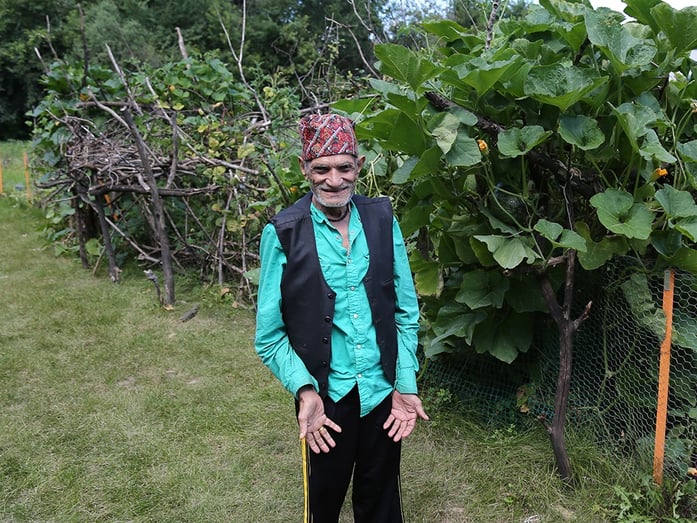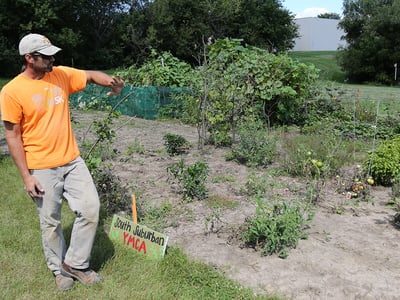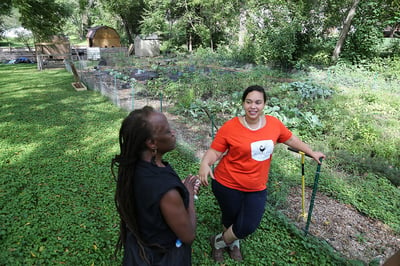
Iowa is 50th in the nation—dead last—when it comes to fruit and vegetable consumption. We eat less green stuff than anybody else.
Some community members are working to change that by creating community gardens. These shared spaces allow neighbors to grow and eat fresh fruit and vegetables, including ones you might never find in a grocery store.
“We wanted to infuse healthy food into the community,” says Tyler Weig, executive director of the South Suburban YMCA, which launched 48 plots this year on land that was previously unused lawn. “This was an opportunity to talk about the need for healthy food, for fruits and vegetables.”
United Way of Central Iowa supports 20 community gardens throughout the area with mini grants of $1,500 or less—totaling $25,000 last year. We toured several of these gardens this fall during harvest time to get the lay of the land. Here’s their advice for newbies.
- Plan, plan, plan. “Planning is everything,” says Oweni Morring, who helps lead the garden at St. James Lutheran Church in Urbandale. Think deeply about what you want the garden to be.Every community garden is different, and there are no right answers to these questions.
- Will it be a neighborhood garden or part of a church or organization?
- Do you want one large garden or a number of individual plots?
- Will people pay to rent plots? If so, will you offer any free for low-income families?
- Who will receive the produce you grow: the gardeners or a community organization?
- Find volunteers with the right skill sets. When you are looking for partners, think about what skills would complement your own. If you’re business-savvy but not a master gardener, find someone with a green thumb. If you love gardening but can’t stay organized, look for a partner who knows project management.
 Form a committee. It works best when there is a structure in place for garden management, and everyone understands how and when decisions are made. You can go formal with elected positions, or just decide on a few leaders who will vote on any issues. Having a plan in place now will prevent fights and indecision in the future.
Form a committee. It works best when there is a structure in place for garden management, and everyone understands how and when decisions are made. You can go formal with elected positions, or just decide on a few leaders who will vote on any issues. Having a plan in place now will prevent fights and indecision in the future.- Partner with another organization that already knows the neighborhood. The South Suburban YMCA brought in Lutheran Services in Iowa to recruit the refugees who live in that area. More than half their plots are now rented by refugees who live in a nearby housing complex and otherwise have little access to land or fresh produce. The Altoona Community Garden donated plots to the child care center Kids Klub and involved local 4-H groups.
- Tour other community gardens. Before you put any seed in the ground, get ideas on layout, species selection, fencing and volunteer management from people who are already doing it. Contact me for a list of community gardens near you.
- Prep in the fall. Autumn in the perfect time to consider what spring will bring. Do as much planning as you can now. If you have time to put up fencing or raised beds before the snow hits, that’s a plus. “In the spring, we’re ready to just stick stuff in the ground,” says Morring.
 Have regular work nights. Once your garden is planted, keep your gardeners and volunteers engaged by having regular work nights where everyone comes together to weed or harvest, as Sankofa Urban Farm in Des Moines does. Even if you have individual plots rather than one large garden, getting people there at the same time encourages a sense of community that keeps the garden going.
Have regular work nights. Once your garden is planted, keep your gardeners and volunteers engaged by having regular work nights where everyone comes together to weed or harvest, as Sankofa Urban Farm in Des Moines does. Even if you have individual plots rather than one large garden, getting people there at the same time encourages a sense of community that keeps the garden going.- Include everyone. The Altoona garden makes an effort to reach out to senior citizens or the chronically ill. A small plot can do these individuals good, especially if they have volunteers or other gardeners to assist them. St. James recruits those who aren’t up for a lot of physical activity to grow seedlings in their homes in the early spring.
- Keep it tidy. Terri Heinkels of Altoona advises planting flowers too, so that neighbors can enjoy a beautiful space. She is in the process of making the flower garden a designated monarch waystation.
- Consider donation. Whether you donate the entire crop or just encourage individuals to donate extra produce, donation can make a big difference to pantries and shelters in the community. The individuals served by these agencies often lack access to affordable healthy food. St. James donates everything they grow to a local pantry. Oweni encourages every volunteer to do drop-off at least once.
“When you drop off the food and see how eager the people are to get their hands on fresh produce, it makes a big difference in the way you see your garden.”
CTA Headline Goes Here Lorem Ipsum Dolor Sit Amet
Lorem ipsum dolor sit amet consectetur. Quis congue varius a.
